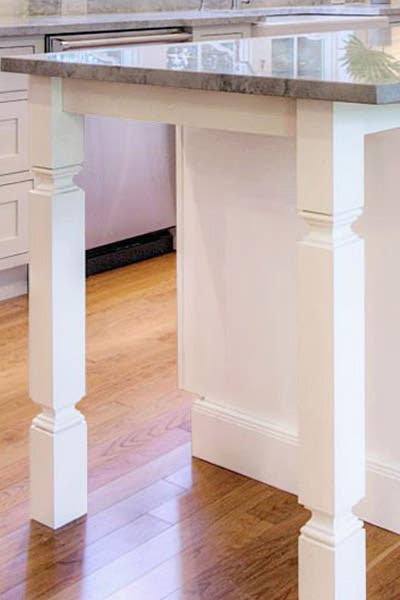Boost Functionality and Design Using High Quality Legs For Kitchen Island
Wiki Article
An Overview to Choosing the Perfect Legs For Kitchen Area Island for Your Home
Selecting the optimal legs for your cooking area island is a nuanced decision that affects both the performance and visual appeal of this central area. As you think about these components, it ends up being obvious that the ideal legs can transform not only the appearance of your kitchen however likewise its use for years to come.
Understanding Kitchen Area Island Legs
When choosing legs for a cooking area island, it's important to comprehend their visual and practical duties in the total layout. The legs offer as an essential support system, making certain security and toughness for the island, which often functions as a work area, dining area, or collecting area. The choice of product and building and construction method need to be robust sufficient to stand up to day-to-day usage and potential wear.In addition to their structural obligations, legs add dramatically to the island's aesthetic charm. They can enhance the cooking area's style, whether via traditional, modern, or diverse designs. The height and percentage of the legs are additionally essential considerations; they should integrate with the island's kitchen counter height while making sure comfy seating for those using the room.
In addition, the leg style can affect the general flow of the kitchen. Open, ventilated leg styles can develop a sense of lightness, while strong, substantial legs may convey an extra based and steady aesthetic - Legs For Kitchen Island. Comprehending these useful and aesthetic elements will assist house owners in making notified selections that match their kitchen's layout and improve its use
Popular Styles and Materials
The selection of legs for a kitchen area island encompasses a range of popular styles and materials, each offering special features that can enhance both performance and appearances. Traditional legs commonly exhibit ornate information and workmanship, boosting classic cooking area layouts.
Height and Security Factors To Consider

Stability is another crucial consideration. The legs of the kitchen area island must give ample assistance, making sure that the framework can endure everyday usage without shifting or wobbling. Material selection plays a considerable duty in security; metal legs, for example, often tend to supply better strength compared to wood. In addition, ensuring that the island is safely secured to the floor or wall can improve security, particularly for larger islands that may bear significant weight.
Matching Your Kitchen Area Aesthetic
Picking the ideal legs for your kitchen island goes beyond capability; it likewise plays a considerable role in the general visual of the room. When selecting legs, take into consideration the design style of your kitchen area. For a contemporary appearance, sleek metal or minimalist styles can produce a tidy, modern-day ambiance. On the various other hand, rustic or typical kitchens typically take advantage of wood legs with complex describing or a troubled coating, boosting heat and personality.Shade is an additional essential variable. Legs that enhance or comparison with your island's surface and surrounding cabinetry can develop aesthetic consistency or striking focal points. As an example, coupling dark timber legs with a light marble counter top can add depth and passion. Furthermore, consider the coating of the legs; matte, shiny, or distinctive finishes can significantly influence the total feel of the kitchen.
Installation and Upkeep Tips
Installing cooking area island legs needs cautious interest to information to ensure both stability and visual charm. Begin by picking an appropriate area for your island, guaranteeing it is degree and has enough space for activity. look at this website If you are connecting the legs to a wall or utilizing braces for added assistance, use a stud finder to find wall surface studs. Mark the placement of the legs precisely prior to boring.When safeguarding the legs, utilize top notch screws and, if necessary, wood adhesive for added toughness. For metal legs, make certain that you are making use of suitable anchors and tools to stop damages to your flooring. It is advisable to inspect for levelness after installment, making changes as needed to avoid wobbling.
Maintenance is similarly vital for longevity - Legs For Kitchen Island. Frequently inspect the legs for any kind of indicators of wear or helping to loosen, specifically in high-traffic locations. Tidy the legs with an ideal cleaner, staying clear of abrasive products that might go right here damage the surface area. For wood legs, take into consideration using a timber conditioner occasionally to keep their coating. By complying with these installment and upkeep ideas, you can make sure that your kitchen area island legs stay both practical and visually appealing.
Verdict
In conclusion, choosing the appropriate legs for a kitchen area island requires careful factor to consider of elevation, stability, and visual compatibility. Ultimately, thoughtful leg choice plays an essential function in boosting both the functionality and design of the cooking area space.When choosing legs for a cooking area island, it's important to comprehend their functional and aesthetic roles in the general layout. Open, ventilated leg styles can produce a feeling of agility, while solid, considerable legs might convey a more grounded and steady visual. The legs of the kitchen island ought to supply adequate support, ensuring that the structure can stand up to day-to-day usage without tottering or shifting.Setting up kitchen area island legs needs mindful focus to information to guarantee both stability helpful site and aesthetic charm.In final thought, choosing the ideal legs for a cooking area island necessitates careful consideration of height, stability, and aesthetic compatibility.
Report this wiki page